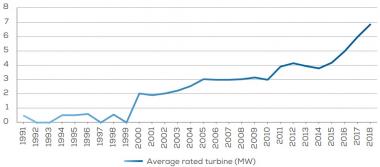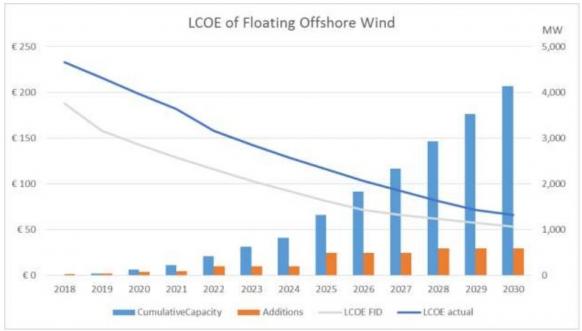Offshore turbine blueprint offers pathway to 20 MW models
A new supersized reference turbine design will help fixed and floating wind developers tackle looming weight and loading challenges, research partners told New Energy Update.

Related Articles
Aggressive price competition is driving a rapid expansion in offshore turbine capacities, pressuring design groups to innovate fast.
By 2023-2025, SSE renewables and Equinor will install 12 MW GE Renewable Energy turbines at three 1.2 GW offshore wind projects in the UK and higher capacities are expected in the coming years.
Average capacity of new offshore turbine installations
(Click image to enlarge)
Source: WindEurope, February 2020
In a boost for developers, last month the US National Renewable Energy Laboratory (NREL) launched a new 15 MW IEA reference turbine design, a major capacity leap from existing reference models.
Valid for fixed-bottom and floating wind designs, the reference design provides open access to a complete wind turbine system allowing technology developers to evaluate performance and cost ahead of prototype development.
Developed with the Technical University of Denmark (DTU) and the University of Maine, the new reference capacity serves as a baseline for 15 to 20 MW designs.
The researchers developed a conservative model using existing technologies and processes, including insights from industry on manufacturing and transport constraints, Evan Gaertner, project design lead at NREL, told New Energy Update.
The reference turbine will foster further innovations on all major turbine components and technologies, Gaertner said.
"We expect exciting innovations to come in the many paper studies and industry collaborations that use the [reference design] as a starting point,” he said.
The design is already being used to develop lightweight generators in floating support structures and to test turbine software tools. Larger capacities and distances from shore will make component weight critical and co-design approaches will help accelerate cost reductions, researchers said.
Tailored designs
The IEA Wind 15 MW is based on a turbine height of 150 meters and rotor diameter of 240 meters. The reference has the same design for rotor-nacelle assembly as existing smaller turbines, but different platform and tower requirements.
NREL designed the rotor, generator, drivetrain, nacelle, tower, monopile and controller while the University of Maine designed the semisubmersible floating wind substructure based on its patented design. DTU provided design feedback, performed load analysis and developed public domain models for the simulation toolsets.
The reference design will be critical for reducing the cost of emerging floating wind designs, Gaertner said.
Floating wind concepts open up project opportunities in vast deep water areas. Developers are working hard to reduce costs, developing more lightweight, leaner designs and advanced controls.
One area in which the reference design will help is in the development of customized rotors and drivetrains for floating applications, Gaertner said.
Europe floating wind cost forecast
(Click image to enlarge)
Source: WindEurope's Floating Offshore Wind Energy: a Policy Blueprint for Europe (October 2018)
The reference models are based on coupled aeroelastic hydrodynamic physics that combines wind and marine load analysis, allowing researchers to predict power performance and load for the floating wind turbine, Habib Dagher, Professor of Structural Engineering at the University of Maine, told New Energy Update.
Wind turbine suppliers and offshore contractors are among the companies starting to reference the design, Dagher said.
These models will drive new innovations in "design, materials and controls,” he said.
The reference will help developers minimize blade weights as dimensions grow, Katherine Dykes, Head of Section, Loads and Control at DTU Wind Energy, said.
“As the rotor diameter grows, the swept area (and potential power production) grows quadratically while the volume of blades grow cubically," she noted.
Carbon blade solutions remain relatively high cost and potential solutions could include aeroelastic tailoring for passive load alleviation, novel air foils and other advanced materials, Dykes said.
DTU Wind Energy, Technical University of Munich, Sandia National Laboratories, NREL and various commercial groups are all conducting research in this area, she said.
Group effort
Many design groups remain reticent to collaborate during development, despite the potential wider benefits.
Co-design approaches with operators could improve development efficiency, pinpointing specific project needs from the start, Dykes said.
“While some aspects of co-design have been used in practice for decades, full-blown co-design is still in an early research phase,” she said.
In particular, floating turbine development could benefit from co-design processes because platform movement introduces a higher degree of freedom in the system dynamics, Dykes said.
More operator-focused approaches to design, development and operation would improve asset performance, she said.
The University of Maine and NREL are now using co-design methods to research advanced turbine controls and hull flexibility.
The partners recently received federal funding to build datasets for 15 MW floating wind turbines using advanced controls, by studying 1:60 scale models.
"The experiments will generate data for floating offshore wind turbine loads, motion and performance, while operating with advanced turbine and platform controls in realistic wind and waves," the University of Maine said.
Reporting by Neil Ford
Editing by Robin Sayles


